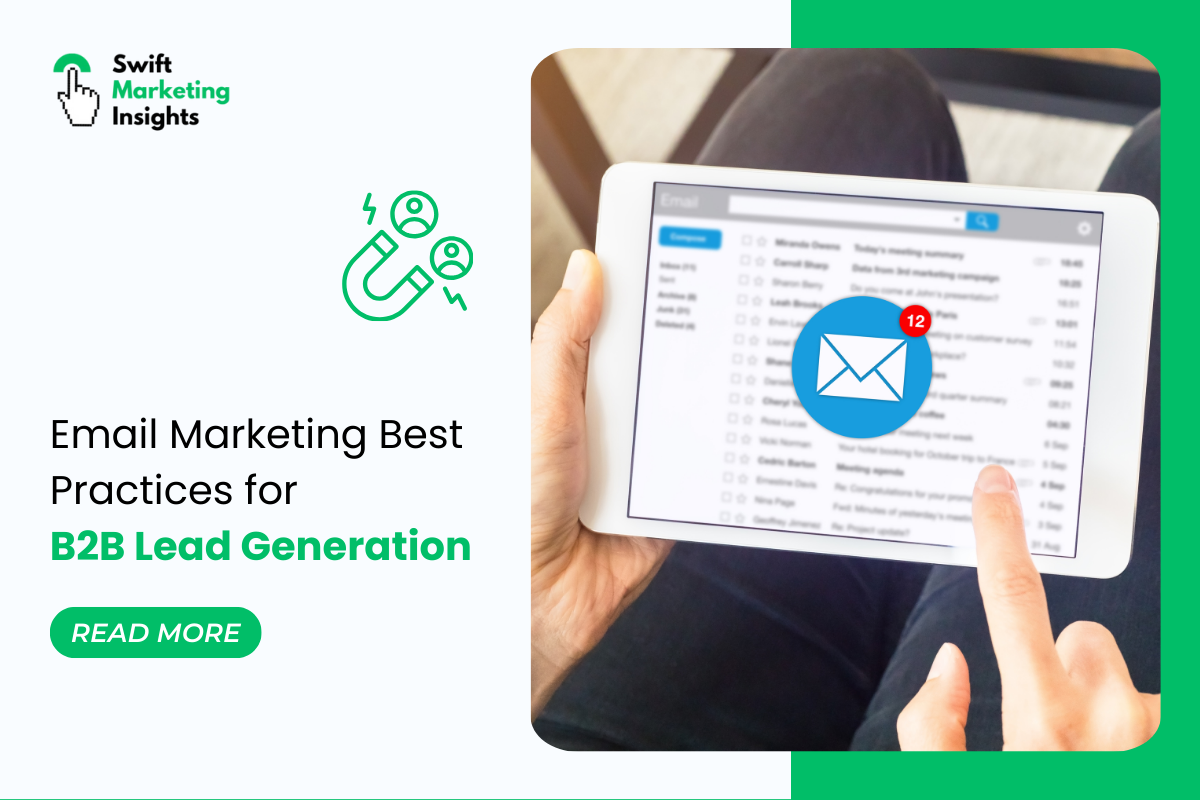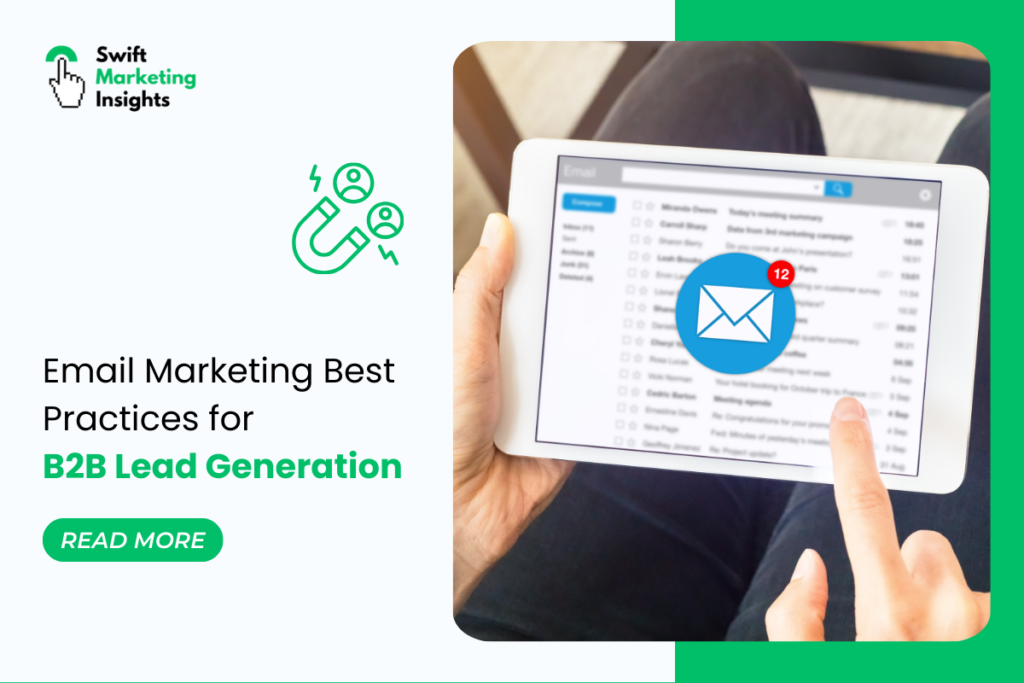

Email marketing is still one of the best ways to get new business leads in 2024. For B2B companies, it’s a powerful tool to connect with potential clients. In this guide, we’ll explore the best ways to use email marketing for B2B lead generation. We’ll keep things simple and easy to understand, so anyone can apply these tips.
1. Why Email Marketing Matters for B2B Lead Generation
Email marketing is important for B2B companies because:
- It’s cost-effective
- You can reach many people at once
- It’s easy to measure results
- You can personalize messages
- It helps build long-term relationships
In 2024, email is still a top choice for business communication. That’s why it’s great for finding new leads and turning them into customers.
2. Setting Up Your Email Marketing Strategy
Before you start sending emails, you need a good plan. Here’s how to create one:
- Define Your Goals: What do you want to achieve? More leads? Better quality leads? Be clear about your aims.
- Know Your Audience: Understand who you’re emailing. What are their needs and challenges?
- Choose the Right Tools: Pick email marketing software that fits your needs. Popular options include Mailchimp, Constant Contact, and HubSpot.
- Build Your Email List: Collect email addresses ethically. Use sign-up forms on your website and at events.
- Plan Your Content: Decide what types of emails you’ll send (newsletters, promotions, etc.) and how often.
3. Creating Effective Email Content
Good content is key to successful email marketing. Here’s how to make your emails stand out:
- Write Compelling Subject Lines: Your subject line is the first thing people see. Make it interesting and clear.
- Keep It Short and Simple: People are busy. Get to the point quickly.
- Provide Value: Share useful information, tips, or offers that help your readers.
- Use a Clear Call-to-Action (CTA): Tell readers what you want them to do next. Make it easy for them to take action.
- Personalize Your Messages: Use the reader’s name and tailor content to their interests when possible.
- Use Visuals Wisely: Include images or videos, but don’t overdo it. Make sure they load quickly.
4. Email List Segmentation and Personalization
Not all leads are the same. Segmenting your email list helps you send more relevant messages:
- Segment by Industry: Group contacts by their business type.
- Segment by Company Size: Small businesses have different needs than large corporations.
- Segment by Job Role: CEOs might want different information than marketing managers.
- Segment by Behavior: Group people based on how they interact with your emails or website.
- Use Personalization Tags: Most email tools let you automatically add names or other personal info to emails.
5. Email Marketing Automation for B2B
Automation saves time and helps you send the right message at the right time:
- Welcome Series: Set up automatic emails for new subscribers.
- Lead Nurturing: Create a series of emails to guide leads through your sales funnel.
- Triggered Emails: Send automatic emails based on specific actions, like downloading a whitepaper.
- Re-engagement Campaigns: Automatically reach out to inactive subscribers.
- Birthday or Anniversary Emails: Send special messages on important dates.
6. Optimizing Email Deliverability
Your emails won’t work if they don’t reach the inbox. Here’s how to improve deliverability:
- Use a Reputable Email Service: Choose a well-known email marketing platform.
- Keep Your List Clean: Regularly remove invalid or inactive email addresses.
- Avoid Spam Triggers: Don’t use words or phrases that might flag your email as spam.
- Authenticate Your Emails: Use SPF, DKIM, and DMARC to prove your emails are legitimate.
- Monitor Your Sender Reputation: Keep an eye on your email reputation score and address issues quickly.
7. A/B Testing and Optimization
Always try to improve your emails. A/B testing helps you find what works best:
- Test Subject Lines: Try different subject lines to see which gets more opens.
- Test Send Times: Find out when your audience is most likely to read your emails.
- Test Content: Try different layouts, images, or writing styles.
- Test CTAs: Experiment with different calls-to-action to see what gets more clicks.
- Analyze Results: Use your email tool’s analytics to understand what’s working and what’s not.
8. Measuring Email Marketing Success
To know if your email marketing is working, you need to track the right metrics:
- Open Rate: How many people open your emails?
- Click-Through Rate (CTR): How many people click on links in your emails?
- Conversion Rate: How many people take the desired action after clicking?
- Bounce Rate: How many emails don’t reach the inbox?
- Unsubscribe Rate: How many people opt out of your emails?
- Return on Investment (ROI): How much business do you get compared to what you spend on email marketing?
9. Compliance and Best Practices
Follow these rules to keep your email marketing legal and respectful:
- Get Permission: Only send emails to people who have agreed to receive them.
- Include an Unsubscribe Link: Make it easy for people to opt out if they want to.
- Be Clear About Who You Are: Include your company name and address in every email.
- Be Honest: Don’t use misleading subject lines or false promises.
- Respect Privacy: Don’t share or sell email addresses without permission.
10. trends in B2B Email Marketing for 2024
Stay ahead by knowing the latest trends:
- AI-Powered Personalization: Using artificial intelligence to create highly personalized emails.
- Interactive Emails: Including elements like surveys or product catalogs directly in emails.
- Mobile Optimization: Making sure emails look good on smartphones and tablets.
- Video in Email: Using more video content to engage readers.
- Data Privacy Focus: Paying more attention to protecting customer data.
11. Overcoming Common B2B Email Marketing Challenges
Here are some common problems and how to solve them:
- Low Open Rates: Improve your subject lines and send at better times.
- High Unsubscribe Rates: Make sure you’re sending relevant, valuable content.
- Poor Click Through Rates: Use clearer calls-to-action and more engaging content.
- Lack of Engagement: Segment your list better and personalize your messages. Spam Complaints: Only send to people who have opted in and provide valuable content.
12. Integrating Email with Other Marketing Channels
Email works best when it’s part of a bigger marketing plan:
- Social Media: Use social media to grow your email list and share email content.
- Content Marketing: Use your blog or website content in emails to provide value.
- Paid Advertising: Use ads to grow your email list or retarget email subscribers.
- Events: Collect email addresses at events and follow up with targeted emails.
- Sales Outreach: Align your email marketing with your sales team’s efforts.
Conclusion:
Email marketing is a powerful tool for B2B lead generation in 2024. By following these best practices, you can create effective email campaigns that attract and nurture leads. Remember to focus on providing value, personalizing your messages, and always testing and improving your approach.
Start by implementing these tips one by one. Keep track of what works and what doesn’t. Over time, you’ll develop an email marketing strategy that brings in a steady stream of quality B2B leads.
Remember, the key to successful email marketing is to be helpful and respectful. Provide value to your readers, and they’ll be more likely to become valuable leads for your business. Happy emailing!






